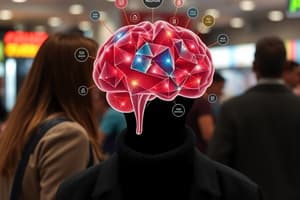Podcast
Questions and Answers
What is the first step in the buyer decision process?
What is the first step in the buyer decision process?
- Post-purchase Behavior
- Evaluation of Alternatives
- Need Recognition (correct)
- Information Search
Which of the following is NOT considered a type of buying behavior?
Which of the following is NOT considered a type of buying behavior?
- Complex Buying Behavior
- Dissonance-reducing Buying Behavior
- Variety-seeking Buying Behavior
- Spontaneous Buying Behavior (correct)
In which stage of the new product adoption process does a consumer start using the product for the first time?
In which stage of the new product adoption process does a consumer start using the product for the first time?
- Trial (correct)
- Awareness
- Evaluation
- Interest
Which social class measurement does NOT apply to influences on buying behavior?
Which social class measurement does NOT apply to influences on buying behavior?
Which adopter category is typically the last to adopt a new product?
Which adopter category is typically the last to adopt a new product?
What is the primary function of the black box in the Stimulus-Response Model?
What is the primary function of the black box in the Stimulus-Response Model?
What does Maslow's hierarchy of needs primarily address?
What does Maslow's hierarchy of needs primarily address?
Which of the following accurately describes perception in consumer behavior?
Which of the following accurately describes perception in consumer behavior?
Which factor significantly influences the changing demand for products across a consumer's life?
Which factor significantly influences the changing demand for products across a consumer's life?
In the context of consumer behavior, what is an attitude?
In the context of consumer behavior, what is an attitude?
How do economic factors influence consumer behavior?
How do economic factors influence consumer behavior?
What role do reference groups play in influencing consumer attitudes?
What role do reference groups play in influencing consumer attitudes?
What forms a consumer's self-concept according to the personal characteristics section?
What forms a consumer's self-concept according to the personal characteristics section?
Flashcards
Consumer Market
Consumer Market
All individuals and households who purchase products for personal use. It focuses on the final consumers' buying behavior.
Perception
Perception
The process of selecting, organizing, and interpreting information from the environment. It involves selective attention, distortion, and retention.
Learning
Learning
Changes in behavior that occur due to experience. It's influenced by stimuli, responses, and reinforcement.
Belief
Belief
Signup and view all the flashcards
Attitude
Attitude
Signup and view all the flashcards
Membership Groups
Membership Groups
Signup and view all the flashcards
Aspirational Groups
Aspirational Groups
Signup and view all the flashcards
Reference Groups
Reference Groups
Signup and view all the flashcards
Social Class Influence
Social Class Influence
Signup and view all the flashcards
Buyer Decision Process
Buyer Decision Process
Signup and view all the flashcards
Customer Journey
Customer Journey
Signup and view all the flashcards
Product Adoption Process
Product Adoption Process
Signup and view all the flashcards
Adopter Categories
Adopter Categories
Signup and view all the flashcards
Study Notes
Consumer Markets & Consumer Behavior
- Consumer market encompasses individuals and households buying products for personal use.
- Consumer buyer behavior focuses on how final consumers purchase goods for personal consumption.
- Stimulus-Response Model (Black Box): Marketing stimuli enter the consumer's "black box" (mind) and are processed; this creates consumer responses.
Psychological Characteristics
- Motivation: A need strong enough to drive a person to satisfy it. Maslow's hierarchy of needs and motivation research explores subconscious motivations.
- Perception: Involves selecting, organizing, and interpreting information; includes selective attention, distortion, and retention.
- Learning: Changes in behavior resulting from experience, involving stimuli, responses, and reinforcement.
- Beliefs & Attitudes: Beliefs are descriptive thoughts, while attitudes are consistent feelings and evaluations towards objects or ideas.
Personal Characteristics
- Age & Lifecycle Stage: Consumer needs and product preferences change during their lifetime; companies tailor strategies to each stage.
- Occupation & Economic Factors: Work strongly influences product demand, and economic factors affect disposable income, which impacts purchasing decisions. Marketers track economic trends.
- Lifestyle: A pattern of living expressed through activities, interests, and opinions.
- Personality & Self-Concept: Personality traits (like confidence) and self-concept (personal beliefs and external perceptions) influence purchasing decisions. Personal identity is woven into consumerism
Socio-Cultural Characteristics
- Groups: Membership groups (direct impact), aspirational groups (desire to belong), and reference groups (shape attitudes) influence buying behavior.
- Social Networks: Online communities, word-of-mouth, opinion leaders, and influencer marketing (micro and macro) are key factors.
- Family: The most influential buying unit, with roles and status within the family affecting decisions.
- Culture & Subculture: Culture shapes basic values and behaviors while subcultures have shared values based on experiences.
- Social Classes: Influenced by occupation, income, education, and wealth, and dictates purchase decisions.
Buyer Decision Process & Customer Journey
- Decision Process: Five steps: Need recognition, information search, evaluation of alternatives, purchase decision, and post-purchase behavior (satisfaction or dissonance).
- Customer Journey: The ongoing experiences influencing buying behavior; this considers the lasting brand engagement and advocacy.
Variations in Buying Behavior
- New Product Adoption Process: Five stages: awareness, interest, evaluation, trial, and adoption.
- Adopter Categories: Innovators, early adopters, early majority, late majority, and laggards describe different speeds of adoption.
- Types of Buying Behavior: Complex, dissonance-reducing, habitual, and variety-seeking describe different consumer motivations and situations.
Studying That Suits You
Use AI to generate personalized quizzes and flashcards to suit your learning preferences.



